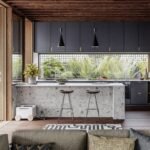The Container House, an innovative farmhouse designed by Rakhee Shobhit Design Associates, is the ideal getaway for the whole family.
Designed by Rakhee Shobhit Design Associates (RSDA), the Container House sets a new paradigm shift in the conventional farmhouse typology. Nestled in the foothills of the Aravalli hills, this project sits on a three-acre farmland that is abundant with greenery. Catapulted by the pandemic and the humdrum of the city, the client’s family sought a life closer to nature and decided to move to their farm.

As an attempt to be mindful of resource consumption and ecology in a highly modernised world, this distinctive dwelling redefines consumption in real estate by being made up entirely of shipping containers. The use of containers has been instrumental in expediting the construction process and ensuring the timely completion of this farmhouse.
Conceptualised as architecture that inhabits the ground without interfering with the natural surroundings, the project comprises two independent units named Champa and Chameli as a tribute to their two beloved family dogs, who passed away before the project commenced. Chameli is a dual-container pod put together by joining two 40 X 8 feet containers lengthwise. On the other hand, Champa features a more complex arrangement of five containers, each 20 x 8 feet in size. Chameli and Champa have been placed on either side of the plot to endow the homeowners with a sense of privacy. The client and his wife reside in Chameli, while the client’s mother lives in Champa, bringing together the coexistence of traditional Indian families.
“Customised technical details have been developed to optimise this project’s unconventional choice of materials. For example, the structure has been lifted fifteen inches off the ground and is supported by hollow metal pipes and a concrete foundation to tackle the influx of harsh rains and protect the house from snakes and other reptiles found near the site. An extruded polyurethane foam (EPF) for insulation lines the interior framework, which is further panelled with 19mm HDMR boards providing thermal and acoustic insulation along with a meticulous finish. Considering the structure is primarily made of metal, it was essential to stabilise any movement or changes in the building owing to the temperature variance. In addition, installing vertical grooves in the joinery between panels helped manage thermal expansion.” explains Shobhit Kumar, Principal Designer, RSDA.

Both units have a bedroom, ensuite bathroom, kitchen, and living area. They feature a minimalist interior palette that echoes the concept of modularity while being inviting and clean-lined. Pops of colour from the furniture offset the muted design grammar. The Chameli unit features an open-plan layout that seamlessly connects the kitchen, bedroom and living area and is enveloped in panelled grain-matched wood veneer. On the other hand, HDMR boards finished in paint adorn the Champa block. Both units feature customised open kitchens made of stainless steel that seamlessly integrate with the interior style. The attached washrooms are finished in vitrified tiles and equipped with top-of-the-line fittings. LED lighting for the indoors and outdoors further helps lower the house’s carbon footprint. Expansive glass walls framed with insulated aluminium open up the facade to accentuate the inside-outside connection and maximise the views.
An eight-foot wide deck runs across the length of both these units, converting the semi-open portico into a seating area to enjoy the outdoors. While Champa has a deck on both the front and back_,_ the rear deck of Chameli transforms into an open-air shower covered with upcycled wooden planks for privacy. A raised, knit bamboo mat roof covers the container pods and wooden deck area, adding a sense of tactility and rusticity to the structure. The bamboo columns that support this roof are held together by coconut ropes, eliminating the use of nails.

The Container House does not conform to conventional residential design ideas. Instead, it employs industrial materials as the exoskeleton to create a homely, cosy setting that creates a spatial dialogue between the interiors and the surroundings.
Photographer: Noughts & Crosses (Mr. Fanthome)














